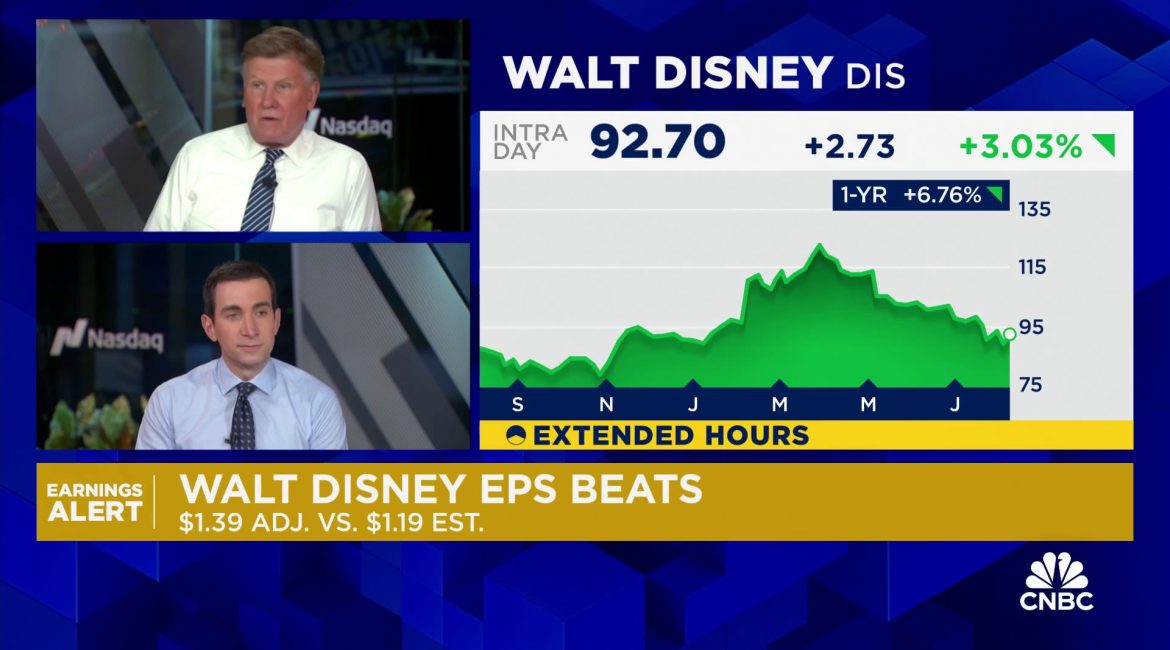
Disney reported its fiscal third-quarter earnings Wednesday, topping analyst estimates as its combined streaming businesses turned a profit earlier than expected.
Here is what Disney reported compared with what Wall Street expected, according to LSEG:
- Earnings per share: $1.39 adjusted vs. $1.19 expected
- Revenue: $23.16 billion vs. $23.07 billion expected
The company’s total segment operating income increased 19% to $4.225 billion compared with the same period last year, led by the positive results for Disney’s entertainment unit, particularly streaming.
Disney’s combined streaming business, which consists of Disney+, Hulu and ESPN+, together turned a profit for the first time — and it happened a quarter earlier than the company had expected.
The combined streaming business posted an operating profit of $47 million compared with a loss of $512 million in the same quarter last year. However, without ESPN+, the direct-to-consumer streaming unit reported a loss of $19 million.
Meanwhile, in May, Disney highlighted a slightly different metric, noting that Disney+ and Hulu together turned a profit, but when combined with ESPN+, the streaming businesses suffered a loss.
Disney recently changed how it reports its segments, with ESPN falling under its sports unit, and Disney+ and Hulu being counted as part of the direct-to-consumer entertainment segment. Disney and its peers have been focused on streaming reaching profitability as the traditional TV business bleeds customers.
Disney+ Core subscribers — which excludes Disney+ Hotstar in India and other countries in the region — increased by 1% to 118.3 million, despite the company’s earlier guidance it wouldn’t add new customers during the fiscal third quarter. Total Hulu subscribers grew 2% to 51.1 million.
Revenue for the entertainment segment was up 4% to $10.58 billion, driven largely by subscription revenue growth due to price increases and customer growth for Disney+ Core. The company announced further streaming price hikes on Tuesday. Revenue for the traditional TV networks was down 7%.
Disney’s overall revenue increased 4% to $23.155 billion compared with the same period last year.
Revenue for ESPN’s domestic and international business — excluding Star India revenue — increased by 5%, largely due to a big uptick of 17% in domestic advertising, as well as growth in subscription revenue. The ad market has started to rebound in recent quarters, particularly for digital and streaming. ESPN’s operating income was up 4% to $1.09 billion.
However, while Disney’s entertainment and sports divisions drove earnings, the U.S. theme parks business was impacted by slowing consumer demand and inflation.
“The portfolio is working well,” Disney CFO Hugh Johnston said. “Yes there was softness in the domestic parks, but the entertainment division’s profit tripled in the quarter.”
Disney’s parks have been a key profit driver, and the company has pledged to spend roughly $60 billion on its theme parks over the next decade.
Revenue for the overall experiences unit, which includes domestic and international parks and experiences, as well as consumer products, was up 2% to $8.386 billion.
Operating income for U.S. parks was down 6%, while international parks operating income was up 2%. The company attributed the decrease in operating income at the domestic parks to higher costs driven by inflation, as well as increased technology spending and new guest offerings.
This carried over from the previous quarter, when the Disneyland Resort in California was under pressure with lower profits, with executives citing similar reasons.
Last month Comcast‘s earnings were weighed down by its Universal theme parks, which the company attributed to increased competition from cruises and international tourism. Despite this, Comcast executives said they remained “bullish” on the business, especially with a new theme park opening in 2025.

